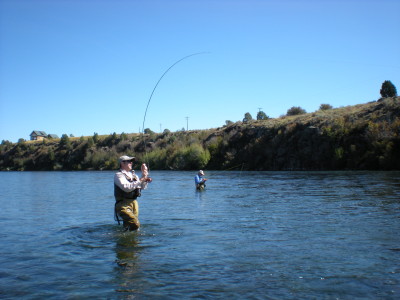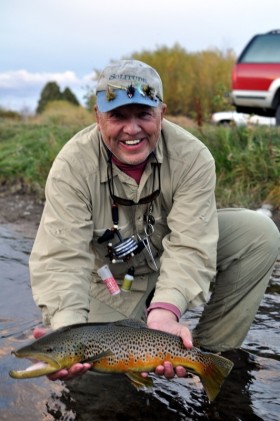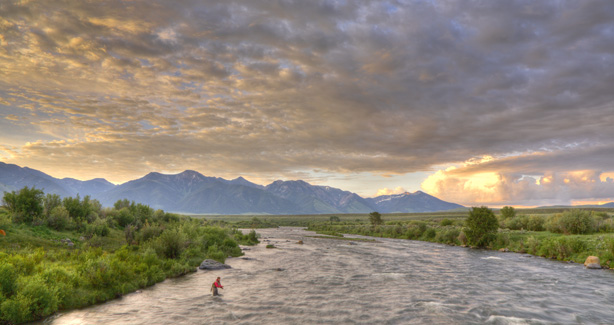HENRY’S FORK OF THE SNAKE RIVER (IDAHO) (steps from the back porch of the Wildfin Lodge)
 The Wildfin Lodge is located on the banks of one of the most famous trout streams in all of the United States. The Henry’s Fork encompasses 1.7 million acres and over 3,000 miles of rivers, streams and canals in eastern Idaho and western Wyoming. Here, you will find some of the finest fishing in the entire United States.
The Wildfin Lodge is located on the banks of one of the most famous trout streams in all of the United States. The Henry’s Fork encompasses 1.7 million acres and over 3,000 miles of rivers, streams and canals in eastern Idaho and western Wyoming. Here, you will find some of the finest fishing in the entire United States.
The Henry’s Fork derives its name from Andrew Henry, an early fur trader and partner in the Missouri Fur Company. Henry first entered the Snake River plateau in 1810 and built Fort Henry on the upper Snake River, about five miles south of present day St. Anthony. The Henry’s Fork is a tremendous dry fly fishery loaded with many species of trout, large wild rainbows and the ever elusive brown. The river flows through gentle flowing ranch land, timber covered canyons, and spring creek like sections, with tributaries that are spectacular fisheries in their own right.
Below the reservoir is where the “Blue Ribbon” section begins. This 15 mile stretch is catch and release only. As the river enters Box Canyon its faster waters make wading challenging. The river then flows through Harriman State Park with many wide slow pools. The fish are smart here. Further down, you’ll find great fishing between Riverside Campground and just above Mesa Falls. After the falls it merges with the Warm River before reaching the Ashton Reservoir, providing a very accessible stretch of river for anglers. Long story short, there are many sections of the Henry’s Fork suitable for fly fishing.

Harriman State Park:
The Henry’s Fork flows right through Harriman State Park, providing a serene backdrop to horseback riding and hiking trails. The River Trail offers easy access to the river for anglers.
Mesa Falls:
A must see when traveling to or from Island Park, the Mesa Falls Scenic Byway skirts the main road and offers lookouts and short trails to the Upper and Lower Mesa Falls.
Big Springs:
A major source for the Henry’s Fork, Big Springs emerges from the land out of nothing. No fishing allowed here as the springs are home to enormous Rainbow Trout. You can feed the fish though and there is even feed available … it’s a great activity for kids. Another popular activity is to float from Big Springs to Mack’s Inn. Inner tubes and rafts are available at Mack’s Inn.
Riverside Campgrounds:
Riverside Campground is on the banks of the Henry’s Fork of the Snake River, just 15 miles north of Ashton, Idaho. Beautiful Island Park is nearby, where visitors enjoy boating, fishing and exploring local trails.
Box Canyon:
This 3 mile section of river is a tailwater that flushes from the Island Park Dam. While the water is fast and difficult to wade, there is good walk-in access from a variety of parking areas. The Box Canyon is one of the most popular sections of the river for float fishing. It is also very popular with recreational floaters, especially on the weekends. With an average of 3,000 trout per mile, the fast rocky water provides a sanctuary for trout of all sizes. This productive water is home to stoneflies, caddisflies, mayflies, midges and other aquatic insects as well as leeches, crayfish, scuds and other invertebrates. Sculpins and other forage fish are at the top of the food chain for these fast growing trout.
Ora Bridge:
Henry’s Fork of the Snake River – Lower (Below Ashton Reservoir), can very productive for very large trout. Fishing directly below the dam is a great spot, since the launch spot for drift boats is further down the river.
MADISON RIVER (MONTANA) (approx 1 hour away)
 The Madison River is frequently rated as the number one wild trout fishery in North America . This amazing river is one of the most consistent in Montana for producing trophy trout and high fish counts. The dam the forms Hebgen Lake helps to moderate the flows on the Madison resulting in very consistent fishing from April until November. Montana Angler’s Madison River fly fishing guides operate on the entire river from its exit from Yellowstone Park to its end point when it forms the Missouri River. Scenery along the Madison is legendary and ranges from broad valleys lined with rugged mountain peaks to 3000 foot cliff walls in the Bear Trap Canyon Wilderness Area.
The Madison River is frequently rated as the number one wild trout fishery in North America . This amazing river is one of the most consistent in Montana for producing trophy trout and high fish counts. The dam the forms Hebgen Lake helps to moderate the flows on the Madison resulting in very consistent fishing from April until November. Montana Angler’s Madison River fly fishing guides operate on the entire river from its exit from Yellowstone Park to its end point when it forms the Missouri River. Scenery along the Madison is legendary and ranges from broad valleys lined with rugged mountain peaks to 3000 foot cliff walls in the Bear Trap Canyon Wilderness Area.
